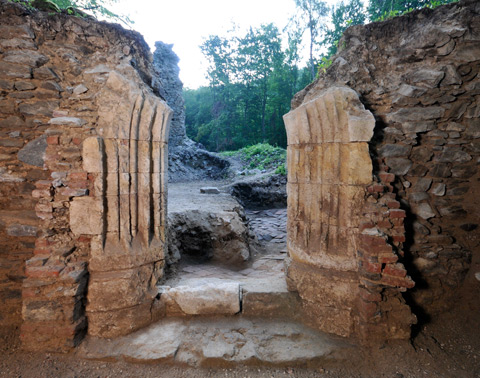
The Monastery of the Blessed Virgin Mary (Bela Crkva, Eng. White Church) in Moslavačka Gora was founded in the second half of the 13th century. It is the oldest Pauline monastery in the territory of present-day Croatia. Research, accompanied by conservation construction works of this monastery in Moslavina and one of the most important late medieval sacral buildings of continental Croatia, has been conducted by the Croatian Conservation Institute since 2009. Research has so far included the monastery church of the Annunciation of the Blessed Virgin Mary, located in the northeastern part of the monastic complex. On its western front, two Late-Gothic portals were discovered in situ: the richly-carved main entrance to the church and a more simple entrance to the cloister. The main portal was conserved at the Department for Stone Sculpture of the Croatian Conservation Institute, and is to be permanently displayed at the Museum of Moslavina in Kutina, beginning from the “Night of the Museums” on 25th January 2013.
The oldest Pauline monastery in the territory of present-day Croatia is situated at the foot of the highest peak of Dugačko Brdo in Moslavačka Gora, in an inaccessible ravine of the Kamenjača Stream. The monastery of the Blessed Virgin Mary (Bela Crkva, Eng. White Church) was founded in the second half of the 13th century. During the 14th and the 15th century, the monks acquired ownership of a large number of estates by numerous charters of donation and testaments. This provided the monastery with significant political and economic influence. The Paulists abandoned the monastery due to an increasing danger from Ottoman attacks in the period between 1520 and 1544.

The research accompanied by conservation construction work on the Pauline Monastery of the Blessed Virgin Mary in Moslavina, which is among the most important late medieval sacral buildings in continental Croatia, is conducted by the Croatian Conservation Institute.
The monastery is situated on a raised rectangular plateau, defined on all four sides by the Crkveni Jarak Stream. During the two seasons of archaeological excavations (2009-2010), the research centered on the Church of the Annunciation of the Blessed Virgin Mary (31.5 x 10.5 m), located in the northeastern part of the monastic complex. The church was built according to the custom of mendicant orders: its longitudinal axis is emphasized by a single rectangular nave and a polygonal ending to the sanctuary, which is of approximate dimensions. In its western front, two Late-Gothic portals were discovered in situ: the richly-caved main entrance to the church and a smaller and simpler entrance to the cloister. Both portals were carved in calcarenite.
Photo album
Segments of the main portal were disassembled and transported to the Department for Stone Sculpture of the Croatian Conservation Institute, where they were soaked in stone consolidant and partially reconstructed, to ensure them long-lasting protection. Owing to the excellent cooperation with the Museum of Moslavina, the Conservation Department in Sisak and the Town of Kutina, this valuable find of Late-Gothic architectural sculpture will be exhibited in its newly-acquired splendour, as part of the permanent exhibition of the Museum of Moslavina, beginning from the “Night of the Museums” on 25th January 2013.
















